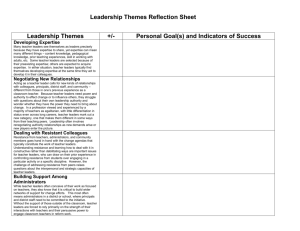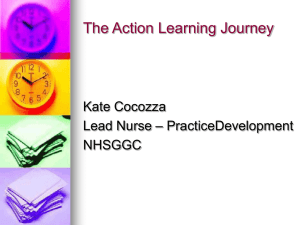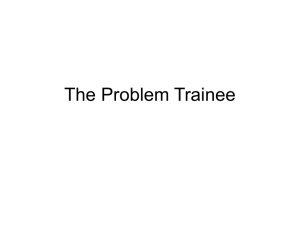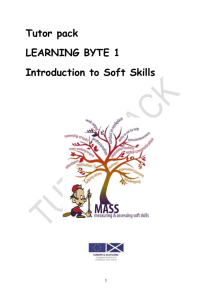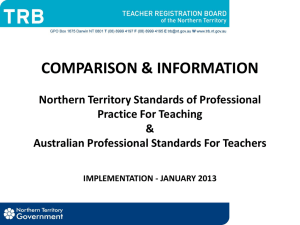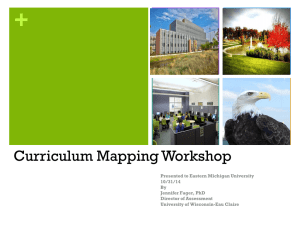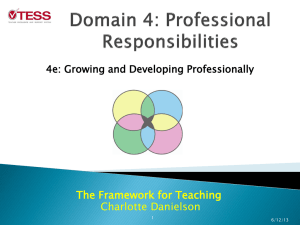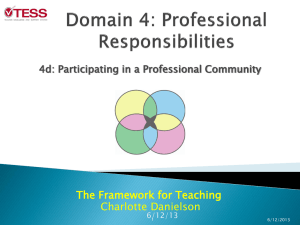Understanding how the effectiveness of store operations can be
advertisement
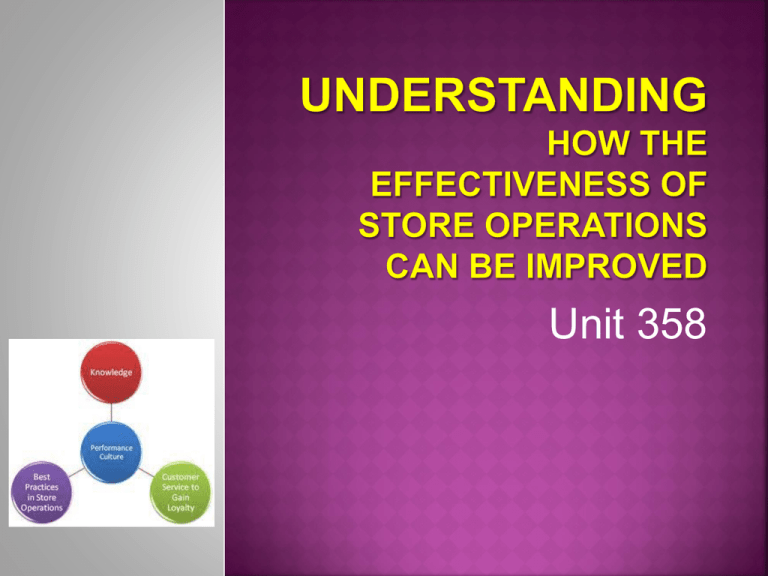
Unit 358 There are three learning outcomes to this unit. 1. Understand the process of improving store operations. 2. Understand how to communicate with and motivate those involved in bringing about change and improvement in store operations. 3. Understand how the organisation and scheduling of staff contributes to the effectiveness of store operations. Improving store operations begins with monitoring the current performance in order to identify areas that offer opportunities for improvement. The methods used for monitoring operational performance include comparison of the current year’s performance against previous years. This can be carried out for sales either in the business as a whole, floor by floor or department by department. Similar comparisons can be carried out for costs. Another method is to compare actual performance in sales and costs against budgets, targets and plans. This may be a more useful comparison as the budget will have taken into account known variables, but only if the budget has been set realistically. Stock taking results will indicate whether there is a need for improvement in security or in record keeping. Monitoring the performance of the people in the business is carried out through regular appraisals and identifying development opportunities. Product performance can be analysed to identify where stock is being given more floor space than is justified by the sales. ✓✓ People. This means developing the skills of management and staff and ensuring the right people are in the right job roles. ✓✓ Product. This means having the right amount of product on sale in the right amount of floor space. ✓✓ Price. This means having products on sale at the right price; not necessarily as cheaply as possible, but at the price that will bring in most profit. ✓✓ Place. This means having the products on sale in the right place, which may involve developing on-line shopping channels or opening smaller or larger branches. ✓✓ Process. This means looking at all of the systems and checking that they contribute to profit by either increasing sales or reducing costs. ✓✓ Physical evidence. This refers to the customer’s experience in using the product or service. ✓✓ Promotions. This means looking at the way the products are advertised to the customers, both inside the store and through advertising, as well as price reductions etc. Monitoring and review will also identify the business areas where improvement can be made. It will then be necessary to select the most beneficial areas taking into account a number of issues. The first consideration will be cost; there is no point in making an improvement which costs more than the increased profits it generates. The business must look at the return on investment the proposed improvement will bring. Next is the question of time; is there time to carry out the improvement and is this the best time for it? There is then an issue of priorities; would the people who need to be involved in the change be better utilised elsewhere? Disruption to the business must also be considered; customers who are faced with a building site in part of the store may take their custom elsewhere and not return while staff may also not appreciate working in confusion. Having selected an improvement that meets all of the criteria a plan for carrying out the improvement must be made. SWOT analysis (the identification of strengths, weaknesses, opportunities and threats) can be used to choose between different ways of moving forward. The whole project can then be scheduled, setting milestones for the completion of stage. A critical path analysis can then be carried out, which identifies the duration of individual tasks and their dependency on each other, i.e. which tasks cannot start until others are complete. This will give an overall timescale for the project and may require the schedule to be adjusted. Flow charts may be produced to show the stages of the process pictorially as this makes it easier for many people to understand the development. An important area of planning an improvement is looking at the budgeting aspect. The components of the project must be identified and each costed as accurately as possible. This means getting quotes for outside work and remembering to include all the costs involved in using your own team and facilities. The total cost can then be included in the business plan which will demonstrate that the improvement will lead to increased profits. This business plan will be presented to whoever is providing the capital to carry out the improvement. Customers will need to be informed of changes if they directly affect them. This may be done by displaying posters in the store where structural change is taking place or by writing to them where a procedural change affects them. The communication must stress the benefits to the customer of the change. Colleagues need to be involved in the change at as early a stage as possible. Keeping colleagues advised of forthcoming change will prevent rumour and concern that proposed changes will adversely affect them. Individuals can be encouraged to bring about improvements if they are motivated. There are many ways to motivate people. The environment in which people work is a major contributor to their feeling of wellbeing; if the proposed change will improve the environment, focus on this when explaining the proposal. Encourage their team spirit; less positive team members can be motivated by the enthusiasm of their colleagues. A major contributor to a motivated workforce is communication. Tell people what is happening involve them in the decision making play, listen to their concerns, trust them to take their part in the change, recognise their contribution and give feedback which is constructive and criticises behaviour not people. The other major contributor is training. If team members will be taking on new responsibilities as a result of the change, they will need to receive adequate training so that they, and you, will feel confident that they will be able to achieve the goals and objectives they will be set without the need for micro-management. It is important to gain the commitment of everybody who is involved if the change is to work. Staff who are implementing a change that they are not committed to will give a negative impression to customers and, where the change is in procedure, will tend to fall back into their tried and trusted ways, often leading to confusion between the new and the old process. One of the variables in achieving objectives and goals in retail businesses is staffing levels. Plans must be made to ensure the right number of colleagues are available to carry out the necessary tasks to achieve the objectives for the day. It is also important to have the right mix of skills and experience to achieve the objectives. In an ideal world there would be no constraints on colleague scheduling; it would be possible to have enough colleagues available to cover every eventuality. However, in the real world, there are limits which must be worked with. Budgets will have been set which determine how much can be spent on staffing; different colleagues will cost different amounts. The mix of colleagues must allow you to remain within budget while meeting the constraint of having people with the correct knowledge and experience. Training colleagues to be multi-skilled will be a great advantage in overcoming these constraints. Other constraints may be procedures which require a minimum number of colleagues on the shop floor at all times and the availability of products and services which may require staff to be present when deliveries are made, for instance. The major constraint on colleague scheduling is time; each colleague will have contracted hours. Exceeding their hours will involve overtime payments or giving time off in lieu, which will reduce your flexibility in future. The Working Time Directive must also be taken into consideration. These constraints affect teams by putting pressure on them to achieve their targets. They affect individual colleagues by placing greater responsibility on them and they affect customers by reducing the availability of colleagues to meet their needs. Resourcing plans will need to be flexible to allow for abnormal situations such as unseasonal weather. A contingency plan will need to be in place so that the unexpected can be dealt with. For instance, heavy snow may make it difficult for the scheduled colleagues to reach the store; other colleagues may live closer to the store or have better transport available. The plan must then be adjusted to bring in the colleague who are able to work. On the other hand, weather conditions may prevent customers from reaching the store and consequently fewer colleagues will be required. The effectiveness of resourcing plans can be assessed by monitoring the achievement of objectives. I If objectives are regularly not met, resourcing plans may need to be reviewed, but care must be taken that assumptions are not made that the reason for the shortfall is the number of colleagues available, there may be other factors to take into account. Feedback from customers will be an indicator. If customers regularly complain that they are waiting too long to be served or having to queue for an unacceptable length of time, colleague scheduling may need to be reviewed. Thank you and good luck

